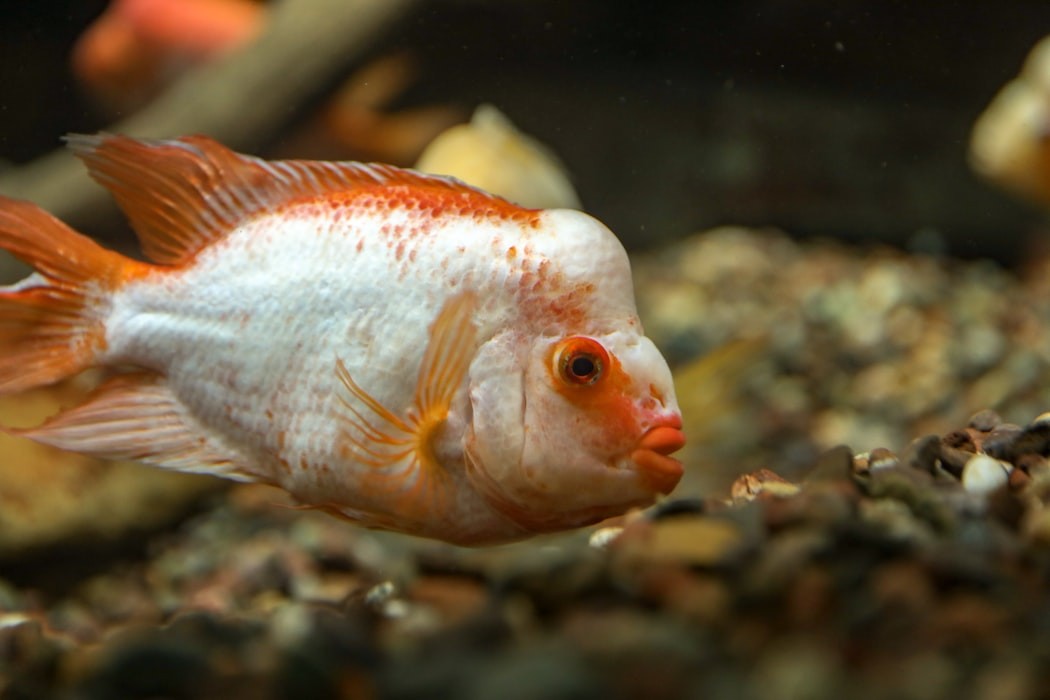
Blood Parrot Fish
This beautiful hybrid aquarium fish makes a great addition to most fish tanks under the right circumstances. Before adding a Blood Red Parrot Fish to your fish tank it’s important that you learn about them and their needs first.
Where did the Blood Parrot Fish Come From?
The Blood Red Parrotfish is a hybrid species that was created in Taiwan back in 1986. The hybrid was derived from a mixture of a Midas and Redhead cichlid fish. These special hybrid fish were not often seen for purchase at pet shop until the 21st century rolled around. If you’re wondering how much these hybrid fish cost, a Blood Parrot Fish price is typically somewhere around $8-$9 at your local pet store.
There is some controversy behind the creation of this fish, and the ethics supporting the breeding of two different species. Especially considering the anatomical deformities that came of the cross-breeding. These deformities are important to be aware of as a Blood Parrot fish owner, as some of them do affect the fish’s ability to thrive.
For instance, their mouth is very small, making it difficult for them to eat normally and at times keep up with feeding before their tank mates take all of the food. This is why it’s important to know what fish interact the best with fish such as the Blood Parrot.
Caring for Blood Parrot Fish
It’s important to know that Blood Parrotfish are shy, timid little fish who would not do well living in a tank with aggressive fish. Because of the small size of their mouth and abnormally shaped body, they would not be able to compete with aggressive fish. Meaning, they would not be able to fight for food or living space very easily. Instead, it’s better to keep them in a tank with community fish that are not aggressive.
Creating a Comfortable Habitat for Your Blood Parrot Fish
Keeping in mind that these fish are incredibly shy and fearful, it is beneficial to them that you provide them a tank with a lot of room as well as hiding places for them. These hiding places can include rocks, logs, and various plant life. Anything that can help your blood parrot fish feel concealed and safe. Not to mention this gives you the opportunity to decorate your tank quite a bit.
As far as water temperature goes, you’ll want to aim to have your tank remain around 80 degrees Fahrenheit at all times. If the water becomes too cold you may notice that your Blood Parrot fish will begin to lose some of it’s the vibrant color or even become sick. The cooler water temperatures can contribute to a weakened immune system in your Blood Parrot fish.
The tanks lighting, if any, should be calm and soft. A red-spectrum light is best, as it is not bright and vibrant, which can overstimulate and stress the fish out. Not to mention a light that’s too bright and powerful could affect the temperature of the water.
These little fish do not grow to be very large, so don’t expect to need to buy a larger tank after some time unless your plan is to add more fish to it in general. The Blood Parrot fish size typically seems to cap out at about 20 centimeters long.
It’s important that you know that these particular fish tend to produce quite a bit of waste. Meaning, it would be beneficial to your fish that you change their water at least twice a month to keep up with the waste production.
Feeding Your Blood Parrot Fish
Blood Parrots are rather easy-going and not very picky when it comes to their meals. They will eat anything from fish food flakes to live food such as blood worms or brine shrimp. They will eat nearly anything you give them, but foods that will sink to the bottom of the tank tend to be easier for them to get to than food that floats at the top.
Conclusion
Blood Parrot fish make great pet fish with their calm and shy personalities. They will get along with any other friendly fish that you have them sharing a tank with. It’s just important to know what fish would live happily with your Blood Parrot before adopting them, to avoid any trouble.
Caring for them is pretty easy but does take a small amount of research before committing to taking one home. For example, it’s important to know that Blood Parrot fish have an easier time eating food that sinks to the bottom of the tank rather than food that floats at the top. Even more importantly, these fish tend to create lot of waste, requiring for you to be on top of cleaning the tank at least twice per month. This may sound like a lot to remember about taking care of a fish, but once you’ve adopted a Blood Parrotfish and begin to enjoy seeing their bright orange color light up your fish tank, you will be glad that you took on the responsibility of caring for them.
Remember to follow me to read more about pets!